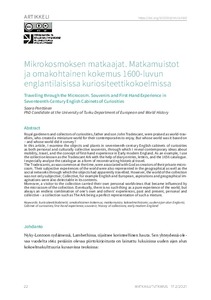Mikrokosmoksen matkaajat. Matkamuistot ja omakohtainen kokemus 1600-luvun englantilaisissa kuriositeettikokoelmissa / Travelling through the Microcosm. Souvenirs and First-Hand Experience in Seventeenth-Century English Cabinets of Curiosities
Penttinen Saara
https://urn.fi/URN:NBN:fi-fe2022081154270
Tiivistelmä
Royal gardeners and collectors of curiosities, father and son John Tradescant, were praised as world-trav-ellers, who created a miniature world for their contemporaries to enjoy. But whose world was it based on – and whose world did it convey?In this article, I examine the objects and plants in seventeenth-century English cabinets of curiosities as both personal and culturally collective souvenirs, through which I reveal contemporary ideas about mobility, travel, and the concept of first-hand experience in Early modern England. As an example, I use the collection known as the Tradescant Ark with the help of diary entries, letters, and the 1656 catalogue. I especially analyse the catalogue as a form of reconstructing historical travel.The Tradescants, as was common at the time, were associated with God as creators of their private micro-cosm. Their subjective experiences of the world were also represented in the geographical as well as the social networks through which the objects had apparently travelled. However, the world of the collection was not only subjective; Collective, for example English and European, aspirations and geographical im-aginations were also detectable in its contents.Moreover, a visitor to the collection carried their own personal worldviews that became influenced by the microcosm of the collection. Eventually, there is no such thing as a pure experience of the world, but always an endless combination of one’s own and others’ experiences, past and present, personal and collective – a collection such as The Ark being a perfect representation of such a mixture.
Kokoelmat
- Rinnakkaistallenteet [19207]
